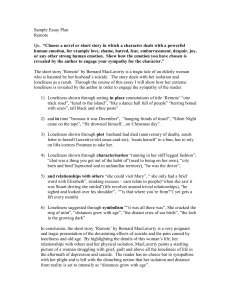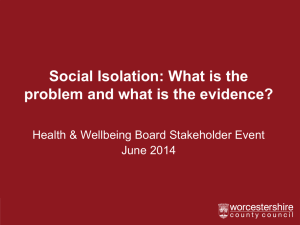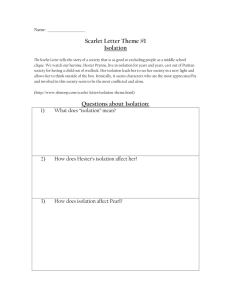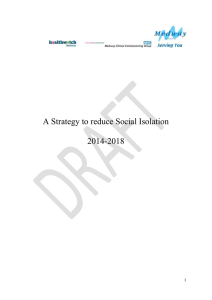here - Medway Voluntary Action
advertisement
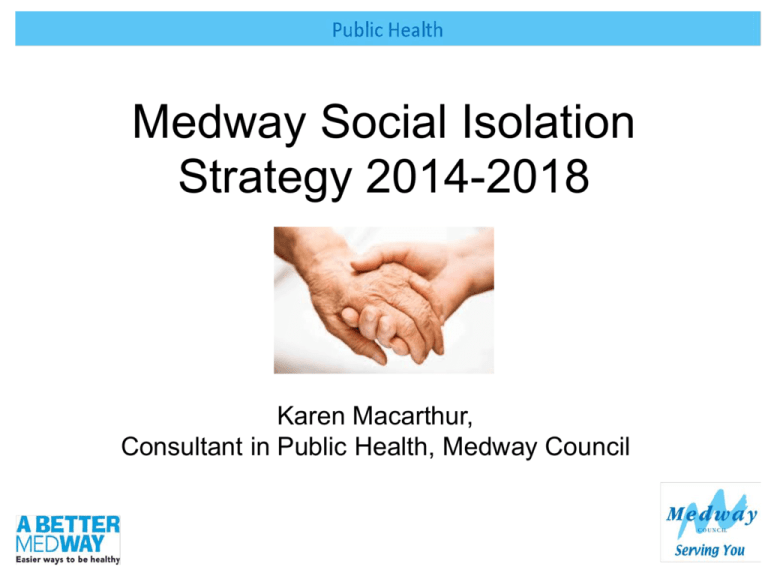
Medway Social Isolation Strategy 2014-2018 Karen Macarthur, Consultant in Public Health, Medway Council Overview • • • • • • Defining social isolation and loneliness and who is at risk The impact of loneliness on health The size of the problem What works in tackling loneliness and social isolation Medway’s “Reducing Social Isolation Strategy” What next? What are social isolation and loneliness? • Social isolation broadly refers to the absence of contact with people. • Loneliness, which is concerned with negative feelings that an individual may have due to a lack or loss of meaningful social relationships. (Social or emotional loneliness..) Or put more simply “Isolation is being by yourself, loneliness is not liking it.” Voluntary sector service provider Who is at risk? • Potentially everyone, but some groups are at a higher risk of being isolated • Older people are significantly more likely to suffer from social isolation with contributing factors being loss of friends and family, loss of mobility, deterioration in physical health or loss of income • Other population groups at risk include carers, refugees and those with mental health problems and those with sensory impairment The impact of loneliness “There is much suffering in the world physical, material, mental.. But the greatest suffering is being lonely, feeling unloved, having no one. I have come more and more to realize that it is being unwanted that is the worst disease that any human being can ever experience.” Mother Teresa Health effects of being socially isolated • Increased risk of dementia, high blood pressure, stress levels and death and poorer immunity (Holt-Lunstead, J. et al. 2010) • People with strong social relationships have a 50% increased likelihood of survival than those with weaker social relationships, comparable with well-established risk factors for mortality such as smoking, obesity and physical inactivity How does loneliness affect health? • Loneliness increases the risk of high blood pressure (Hawkley et al, 2010) • Lonely individuals are also at higher risk of the onset of disability (Lund et al, 2010) • Loneliness puts individuals at greater risk of cognitive decline (James et al, 2011) • One study concludes lonely people have a 64% increased chance of developing clinical dementia (Holwerda et al, 2012) • Lonely individuals are more prone to depression (Cacioppo et al, 2006) (Green et al, 1992) • Loneliness and low social interaction are predictive of suicide in older age (O’Connell et al, 2004 How does loneliness affect health? • Two main models – Buffering/ stress regulator hypothesis. Relationships provide informational/emotional/tangible resources which help reduce stress and reduced stress encourages us to adopt healthy behaviours – Main effects model, social relationships may protect health through more direct means such as emotional and biological influences, changes in brain and body. • High cortisol • Higher risk of hypertension • Link to depression • More focused on self preservation, always vigilant less ability to be empathetic and form relationships Loneliness in Older Adults in the UK • 17% of older people are in contact with family, friends and neighbours less than once a week and 11% are in contact less than once a month (Victor et al, 2003) • Over half (51%) of all people aged 75 and over live alone (ONS, 2010) • Two fifths all older people (about 3.9 million) say the television is their main company (Age UK, 2014) • 63% of adults aged 52 or over who have been widowed, and 51% of the same group who are separated or divorced report, feeling lonely some of the time or often (Beaumont, 2013) • 59% of adults aged over 52 who report poor health say they feel lonely some of the time or often, compared to 21% who say they are in excellent health (Beaumont, 2013) Estimates from national studies • It is estimated that across the present UK population aged 65 and over, that approximately 12% are socially isolated and approximately 10% feel lonely all or most of the time. • If this approximation was applied to Medway this would result in an estimate of 4,698 people over 65 years old being socially isolated and 3915 feeling lonely all or most of the time . Minority ethnic communities • Research conducted on groups who migrated to UK in 1960’s, 1970’s and 1980’s including Indian, African, Chinese, Caribbean, Bangladeshi and Pakistani communities. • 15% reported that they always or often feel lonely compared to 10% in general population • Less likely to say they take part in social activities they enjoy (44% - 79%) • 55% say they have someone who gives them love and affection compared to 88% in the general population • 7% of Indian elders report they are often or always lonely compared with 24% of the Chinese population. 2. What works Evidence shows a number of initiatives can be effective but evidence shows that ; • • • • Befriending, visits or phone contact Mentoring Community ‘Navigators’ or ‘Connectors’ Social group schemes: arts and crafts/cultural/interest, walking groups for over 50’s • Community activities: Asset based community groups • Volunteering schemes: Time Banks Costs • Limited evidence on the cost-effectiveness of interventions to reduce social isolation. • One economic analysis has found that a typical service for befriending would cost around £80 per older person within the first year and provides about £35 in ‘savings’ due to the reduced future need for treatment • One study has found that supportive closed groups can be costeffective and found that there was a saving of €62 per person due to a reduction of hospital bed days, physician visits and outpatient appointments Medway social isolation strategy • In 2014 Medway Health and Wellbeing Board identified social isolation as one of the priorities. • Strategy has been developed and approved Three strategic objectives; • Raising awareness and identifying vulnerable individuals • Action to support individuals • Community action Medway social isolation strategy • Implementation plan developed which went to the Health and Wellbeing Board in September 2015. • Implementation group set up includes representation from Medway Council, Kent Fire and Rescue, Age UK, Carers First, Medway Voluntary Action, Sunlight Development Trust, Nucleus Arts….. Raising awareness and identifying individuals at risk • Social isolation index • Information resource for older people/Citizens Portal • Social isolation summit • Fire and Rescue Service pilot • Social isolation module being developed as part of the “A Better Medway Champions programme” Developing an isolation index for Medway • Isolation index based on MOSAIC consumer classification based on in-depth demographic data • Index can be used to estimate which communities are most affected by loneliness/isolation Relative social isolation per household at lower super output area level of persons aged under 65 Relative estimated social isolation per household of persons aged 65 years and over Direct interventions for individuals and community approaches: • One-to-one approaches Health and Social Care Navigators • Community Approaches CPCE project (DERIC) being developed in the Hoo peninsula and Walderslade. Intergenerational project • Information resource lists the others for older people…. Age UK, Carers First, Men in Sheds, British Red Cross, Contact the Elderly…. What next? Reducing social isolation and loneliness action network Focus on other groups? Other ideas?

